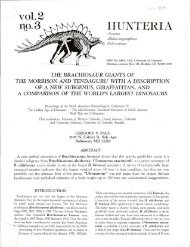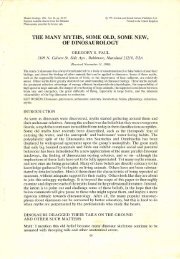THE SEGNOSAURIAN DINOSAURS: RELICS OF ... - Gregory S. Paul
THE SEGNOSAURIAN DINOSAURS: RELICS OF ... - Gregory S. Paul
THE SEGNOSAURIAN DINOSAURS: RELICS OF ... - Gregory S. Paul
You also want an ePaper? Increase the reach of your titles
YUMPU automatically turns print PDFs into web optimized ePapers that Google loves.
e ,<br />
FIGURE 2. Skulls of theropods, early dinosaurs, and segnosaurs. The snout of Scelidosaurus is not known and that of<br />
Hypsilophodon is shown instead. Detail shows inset maxillary teeth of Erlikosaurus. Arrows indicate maximum anterior extent<br />
of cheek tissue as indicated by the anterior extent of the external mandibular shelf and the large nerve foramina. Number with<br />
each specimen indicates the approximate length (in mm) of upper jaw. In part after Owen (1861), Huene (1907), Walker (1961),<br />
Ewer (1965), Galton (1974), Barsbold and Perle (1980), and Perle (1981). Plateosaurus also after Amer. Mus. Nat. Hist, 6310,<br />
Coelophysis after Amer. Mus. Nat. Hist. 39018.<br />
that have cheeks the nerve foramina are always large<br />
and few, but the lateral shelves are often not present.<br />
Theropods and the basal dinosaur Staurikosaurus lack<br />
both of these characters and are cheekless (Fig. 2; also<br />
Galton, 1977 and examination of the holotype of Staurikosaurus,<br />
MCZ 1669). Pro sauropods, however, started<br />
to develop cheeks. In Plateosaurus there is a shelf<br />
running lateral to the sixth to ninth most posterior<br />
dentary teeth (Fig. 2). There are only one or two large<br />
nerve foramina on this shelf, suggesting that short<br />
cheeks covered the posterior-most teeth in Plateosaurus.<br />
Galton (1973a) suggests that the basal fabrosaurid<br />
omithischians lack cheeks. But a shallow lateral shelf<br />
JVP 4(4), December 1984<br />
with a limited number of large nerve openings does<br />
parallel the maxillary tooth row in Fabrosaurus (see<br />
fig. 3 in Thulbom, 1970), suggesting that cheeks were<br />
present. In almost all other omithischians, such as<br />
Scelidosaurus (Fig. 2), the lateral shelves are much<br />
more prominent and the cheeks were better developed.<br />
Though Erlikosaurus lacks a predentary at the tip<br />
of its lower jaws, it has all the major omithischian<br />
feeding adaptations. The premaxilla and anterior dentary<br />
lack tooth alveoli, and are sharply rimmed and<br />
heavily vascularized to support homed beaks (Fig. 2;<br />
see also Barsbold and Perle, 1979; Perle, 1981). A diastema<br />
separates the main tooth row from the upper<br />
509









